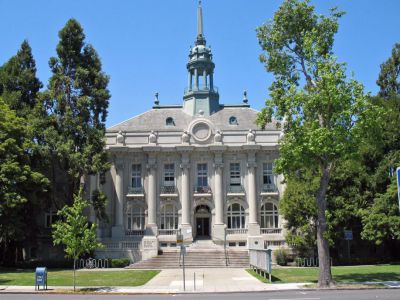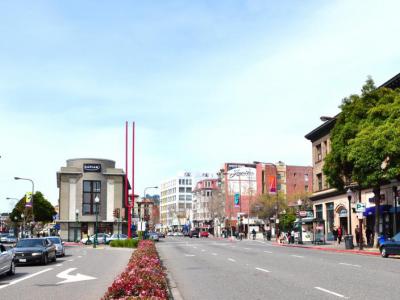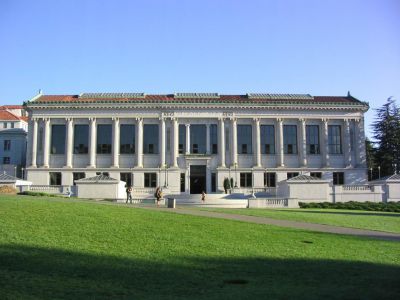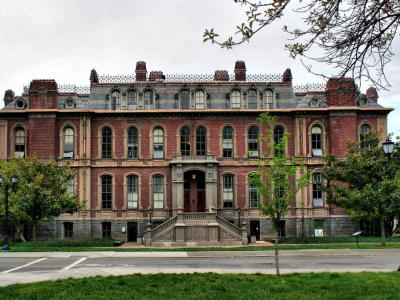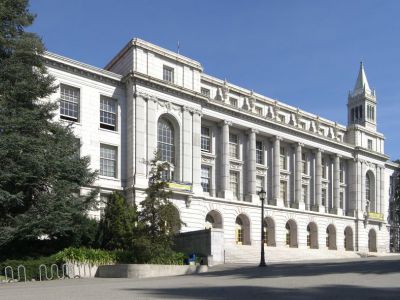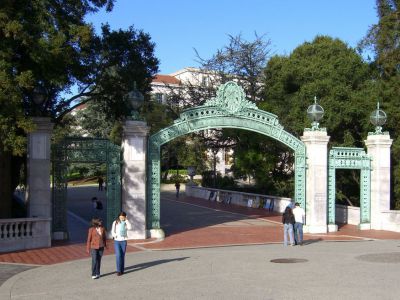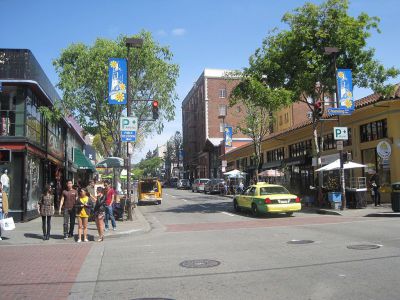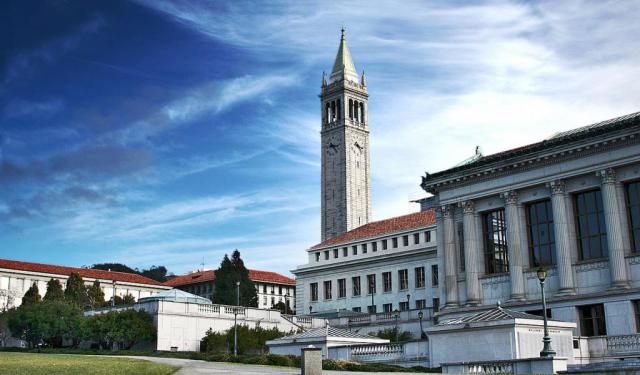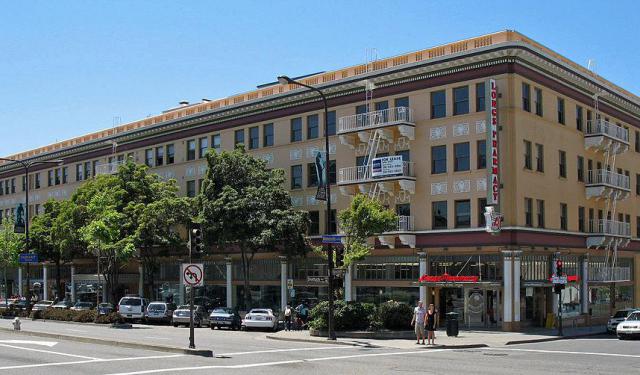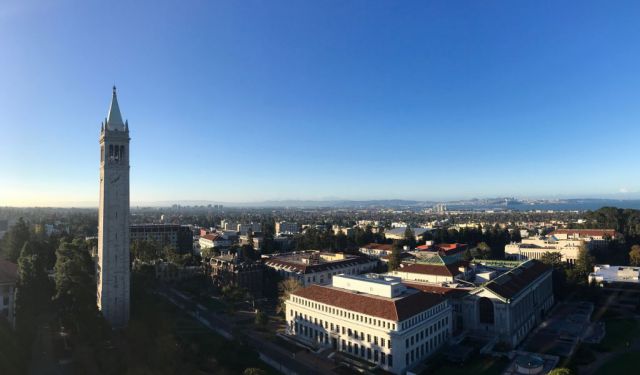
Berkeley Introduction Walking Tour (Self Guided), Berkeley
The Ohlone people were the original inhabitants of the area that is now known as Berkeley, California. Many of them were casualties of the presence of the first settlers of European descent who arrived with the De Anza Expedition of 1776.
Among the soldiers in this expedition was Luis Peralta, who was gifted the land that would become Berkeley by the King of Spain. Peralta gifted the land to his sons upon his death, but the area was swiftly divided into a series of tracts for squatters and others who visited the region during the 1848 Gold Rush.
By the mid-19th century Berkeley was mostly farmland and ranches. That would change with the advent of the College of California. The college was founded in 1866, and then transformed into the University of California two years later.
The city of Berkeley is almost synonymous with the flagship state university. Most think of the Free Speech movement of the 1960s when they conjure images of Berkeley. People's Park is a prime example of a throwback to the civil unrest and protests that put Berkeley in the public eye. However, there were a number of discoveries and inventions at UC Berkeley that bear mentioning. Carbon 14 and photosynthesis were both discovered in Berkeley laboratories. The atomic and hydrogen bombs were invented there as well. The first flu vaccine was created at Berkeley as was the polygraph machine.
Visitors to Berkeley today can tour the campus, walk down historic Shattuck Avenue, marvel at Sather Tower and take a photo at Founders' Rock.
Take this self-guided tour to see these sites and others in Berkeley, California.
Among the soldiers in this expedition was Luis Peralta, who was gifted the land that would become Berkeley by the King of Spain. Peralta gifted the land to his sons upon his death, but the area was swiftly divided into a series of tracts for squatters and others who visited the region during the 1848 Gold Rush.
By the mid-19th century Berkeley was mostly farmland and ranches. That would change with the advent of the College of California. The college was founded in 1866, and then transformed into the University of California two years later.
The city of Berkeley is almost synonymous with the flagship state university. Most think of the Free Speech movement of the 1960s when they conjure images of Berkeley. People's Park is a prime example of a throwback to the civil unrest and protests that put Berkeley in the public eye. However, there were a number of discoveries and inventions at UC Berkeley that bear mentioning. Carbon 14 and photosynthesis were both discovered in Berkeley laboratories. The atomic and hydrogen bombs were invented there as well. The first flu vaccine was created at Berkeley as was the polygraph machine.
Visitors to Berkeley today can tour the campus, walk down historic Shattuck Avenue, marvel at Sather Tower and take a photo at Founders' Rock.
Take this self-guided tour to see these sites and others in Berkeley, California.
How it works: Download the app "GPSmyCity: Walks in 1K+ Cities" from Apple App Store or Google Play Store to your mobile phone or tablet. The app turns your mobile device into a personal tour guide and its built-in GPS navigation functions guide you from one tour stop to next. The app works offline, so no data plan is needed when traveling abroad.
Berkeley Introduction Walking Tour Map
Guide Name: Berkeley Introduction Walking Tour
Guide Location: USA » Berkeley (See other walking tours in Berkeley)
Guide Type: Self-guided Walking Tour (Sightseeing)
# of Attractions: 9
Tour Duration: 2 Hour(s)
Travel Distance: 2.3 Km or 1.4 Miles
Author: Caroline
Sight(s) Featured in This Guide:
Guide Location: USA » Berkeley (See other walking tours in Berkeley)
Guide Type: Self-guided Walking Tour (Sightseeing)
# of Attractions: 9
Tour Duration: 2 Hour(s)
Travel Distance: 2.3 Km or 1.4 Miles
Author: Caroline
Sight(s) Featured in This Guide:
- Old City Hall
- Shattuck Avenue
- Eucalyptus Grove, UC Berkeley
- Doe Memorial Library
- Sather Tower
- South Hall
- Wheeler Hall
- Sather Gate
- Telegraph Avenue
1) Old City Hall
Old City Hall is located in the heart of Berkeley, just three blocks west of the University of California Berkeley campus. The building of this site commenced on June 27, 1908 to replace the previous city hall building that was destroyed by a fire in 1904. The Old City Hall was designed by John Bakewell and Arthur M. Brown, both architects and alums from the local university.
The architects used a French Renaissance style for the building. It was modeled after the Hotel de Ville in Tours, France. This included the ornate tower, which was initially rejected by city planners who felt it was too expensive and unnecessary before eventually agreeing to the design.
The Old City Hall remained in use as an administrative building through 1977. At that time it was re-organized into the administrative building for the Berkeley Unified School District. However, the building now sits vacant and in need of a significant interior overhaul before it can be used again. It has sometimes been used as an emergency homeless shelter, but it is thought to be unstable for long-term use.
Visitors to Berkeley should plan to walk by the Old City Hall to enjoy the beauty of the building and its grounds. It is located directly adjacent to Martin Luther King Jr. Civic Center Park and Civic Center Building. It is also a very close walk from Shattuck Avenue.
The architects used a French Renaissance style for the building. It was modeled after the Hotel de Ville in Tours, France. This included the ornate tower, which was initially rejected by city planners who felt it was too expensive and unnecessary before eventually agreeing to the design.
The Old City Hall remained in use as an administrative building through 1977. At that time it was re-organized into the administrative building for the Berkeley Unified School District. However, the building now sits vacant and in need of a significant interior overhaul before it can be used again. It has sometimes been used as an emergency homeless shelter, but it is thought to be unstable for long-term use.
Visitors to Berkeley should plan to walk by the Old City Hall to enjoy the beauty of the building and its grounds. It is located directly adjacent to Martin Luther King Jr. Civic Center Park and Civic Center Building. It is also a very close walk from Shattuck Avenue.
2) Shattuck Avenue
Shattuck Avenue is a main street in Berkeley that is populated by eateries, shopping and culturally important locations. It is also an access point to the University of California Berkeley. Any visitor to the city should familiarize themselves with this street by planning to include Shattuck Avenue on their walking tour.
The street is considered historic as it is roughly the same corridor that served as a path between the homes of the Peralta brothers in the mid-19th century. When the Spanish settled in the area, a particularly important soldier named Luis Peralta was awarded that land. He left it as an inheritance to his four sons. Two of these sons lived at either end of what is now Shattuck Avenue.
Shattuck runs all the way from Temescal to Berkeley Hills. However, the heart of Shattuck Avenue is in the downtown area. Here, visitors will find numerous businesses. Most of these are restaurants, pubs and cafes. From Downtown Berkeley through North Berkeley, walkers can stop for coffee, pastries, their favorite ethnic cuisine or even fast food. They'll also see important, historic spots like the Tupper and Reed Building.
The street is considered historic as it is roughly the same corridor that served as a path between the homes of the Peralta brothers in the mid-19th century. When the Spanish settled in the area, a particularly important soldier named Luis Peralta was awarded that land. He left it as an inheritance to his four sons. Two of these sons lived at either end of what is now Shattuck Avenue.
Shattuck runs all the way from Temescal to Berkeley Hills. However, the heart of Shattuck Avenue is in the downtown area. Here, visitors will find numerous businesses. Most of these are restaurants, pubs and cafes. From Downtown Berkeley through North Berkeley, walkers can stop for coffee, pastries, their favorite ethnic cuisine or even fast food. They'll also see important, historic spots like the Tupper and Reed Building.
3) Eucalyptus Grove, UC Berkeley
The University of California Berkeley campus has many notable sites and interesting places. One of the most unique is the eucalyptus grove that rests behind the Berkeley Art Museum and Pacific Film Archive.
The grove was planted in 1882 to create a windbreak for a running track that is no longer in place. The Tasmanian blue gums were chosen because they grow tall and strong with great speed.They also do not naturally provide food for any animals in the United States, which keeps their growth from being halted. In addition to this, disease causing insects rarely invade the eucalyptus tree. They stay healthy with very little upkeep.
Eucalyptus is not without controversy in California. The trees are an invasive species that have taken great swaths of native habitat. They are also highly flammable, which make them particularly dangerous in California. The medicinal smell that emanates from the trees is one that beloved by some and bemoaned by others.
Still, the uniqueness of the grove should not be missed. The Eucalyptus Grove at UC Berkeley is the tallest and densest grove of Tasmanian blue gums in the world. It is also the tallest stand of hardwood trees in the continent.
The grove was planted in 1882 to create a windbreak for a running track that is no longer in place. The Tasmanian blue gums were chosen because they grow tall and strong with great speed.They also do not naturally provide food for any animals in the United States, which keeps their growth from being halted. In addition to this, disease causing insects rarely invade the eucalyptus tree. They stay healthy with very little upkeep.
Eucalyptus is not without controversy in California. The trees are an invasive species that have taken great swaths of native habitat. They are also highly flammable, which make them particularly dangerous in California. The medicinal smell that emanates from the trees is one that beloved by some and bemoaned by others.
Still, the uniqueness of the grove should not be missed. The Eucalyptus Grove at UC Berkeley is the tallest and densest grove of Tasmanian blue gums in the world. It is also the tallest stand of hardwood trees in the continent.
4) Doe Memorial Library
The main library on the UC Berkeley campus is Doe Memorial Library. It is located in the center of campus adjacent to Bancroft Library and popular student gathering spot, Memorial Glade.
The library was designed by architect Emile Benard, whose thumbprint can be seen on much of the Berkeley campus. The Neoclassical design of the building is primarily influenced by Benard's time at France's Ecole des Beaux Arts. The library was completed in 1911.
The main stacks of the Doe Memorial Library hold 52 miles books in a four-story underground structure. The library also includes classrooms, offices and exhibit space. It is easy to walk to and from the Bancroft Library from Doe Memorial as the two are connected via walkways on the first and second floors.
The general public is welcome to explore the library while visiting the UC Berkeley campus. However, only students of Berkeley or Stanford University may check out books and equipment. The library is a short walk from Sather Gate and Wheeler Hall.
The library was designed by architect Emile Benard, whose thumbprint can be seen on much of the Berkeley campus. The Neoclassical design of the building is primarily influenced by Benard's time at France's Ecole des Beaux Arts. The library was completed in 1911.
The main stacks of the Doe Memorial Library hold 52 miles books in a four-story underground structure. The library also includes classrooms, offices and exhibit space. It is easy to walk to and from the Bancroft Library from Doe Memorial as the two are connected via walkways on the first and second floors.
The general public is welcome to explore the library while visiting the UC Berkeley campus. However, only students of Berkeley or Stanford University may check out books and equipment. The library is a short walk from Sather Gate and Wheeler Hall.
5) Sather Tower (must see)
The bell tower on the University of California Berkeley campus is called Sather Tower. It was a gift from Jane K. Sather in memory of her husband, Peder. He was a prominent banker and a trustee of the university.
Jane Sather was a well known suffragist and philanthropist. She was a major benefactor in the early days of the Berkeley campus, providing donations in both land and money. The initial $75,000 she gave to the University would be the equivalent of nearly $2 million in today's fund. Sather Tower was an even more robust donation. The $200,000 price tag for the tower translates to more than $5 million in today's rates.
Sather Tower is a Gothic Revival style bell tower with clocks on all four faces. It was designed by architect John Galen Howard who modeled it after the Saint Mark's Square Campanile in Venice. It is the third tallest clock tower in the world and the tallest bell tower outside of Italy, standing at 307 feet tall. There is an observation deck on the tower's eighth floor that has views of San Francisco and the Golden Gate Bridge.
The tower originally held a 12-bell chime. It has been expanded over the years and now contains a 61-bell, full concert carillon. It is performed on regular intervals during the spring and fall semesters and irregularly throughout the rest of the year. The Department of Music at Berkeley offers carillon classes to those who can pass the rigorous musical audition.
Many fossils, particularly those found at the La Brea Tar Pits, are stored within the tower.
Why You Should Visit:
- To see the tallest bell tower in the world outside of Italy
- To take in the views of San Francisco
Tips:
The cost to visit Sather Tower is $4 for each person over the age of 17. Children are free. There is no need to worry about climbing steps to get to the observation deck as there is an elevator inside that will take tourists to the eighth floor.
Jane Sather was a well known suffragist and philanthropist. She was a major benefactor in the early days of the Berkeley campus, providing donations in both land and money. The initial $75,000 she gave to the University would be the equivalent of nearly $2 million in today's fund. Sather Tower was an even more robust donation. The $200,000 price tag for the tower translates to more than $5 million in today's rates.
Sather Tower is a Gothic Revival style bell tower with clocks on all four faces. It was designed by architect John Galen Howard who modeled it after the Saint Mark's Square Campanile in Venice. It is the third tallest clock tower in the world and the tallest bell tower outside of Italy, standing at 307 feet tall. There is an observation deck on the tower's eighth floor that has views of San Francisco and the Golden Gate Bridge.
The tower originally held a 12-bell chime. It has been expanded over the years and now contains a 61-bell, full concert carillon. It is performed on regular intervals during the spring and fall semesters and irregularly throughout the rest of the year. The Department of Music at Berkeley offers carillon classes to those who can pass the rigorous musical audition.
Many fossils, particularly those found at the La Brea Tar Pits, are stored within the tower.
Why You Should Visit:
- To see the tallest bell tower in the world outside of Italy
- To take in the views of San Francisco
Tips:
The cost to visit Sather Tower is $4 for each person over the age of 17. Children are free. There is no need to worry about climbing steps to get to the observation deck as there is an elevator inside that will take tourists to the eighth floor.
6) South Hall (must see)
The oldest building on the University of California Berkeley campus is South Hall. It is also the only building that is original to the university that is still standing today. South Hall was completed in 1973 from a design by Farquharson and Kenitzer in the Second Empire architectural style.
South Hall has served a number of functions over the years. Its first purpose was as the home of the School of Agriculture. Over time, it also hosted the business school, the economics department, the School of Political Science and Sociology, the library school, a museum and an herbarium. It was also the location of the country's first physics lab.
South Hall is still in use as part of Berkeley's graduate school. The Berkeley School of Information is housed in South Hall and is comprised of classrooms, student lounges and work spaces. It has been reconfigured to allow for built-in projectors, audio equipment and wifi.
South Hall has served a number of functions over the years. Its first purpose was as the home of the School of Agriculture. Over time, it also hosted the business school, the economics department, the School of Political Science and Sociology, the library school, a museum and an herbarium. It was also the location of the country's first physics lab.
South Hall is still in use as part of Berkeley's graduate school. The Berkeley School of Information is housed in South Hall and is comprised of classrooms, student lounges and work spaces. It has been reconfigured to allow for built-in projectors, audio equipment and wifi.
7) Wheeler Hall (must see)
Wheeler Hall is arguably the most recognizable building on the University of California Berkeley campus. It is the site that is often featured in representations of the university and the building that houses Berkeley's largest lecture hall. It is home to the university's English department.
Wheeler Hall is designed in the Classical Revival architectural style by architect John Galen Howard. His designs are seen throughout the Berkeley campus, including Sather Tower, Sather Gate and the Memorial Stadium. Wheeler Hall was completed in 1917 to take place of North Hall. The cost of construction was $715,994.
The building was closed in recent years in order to undergo a complete operational transformation. The facade was not changed, but Wheeler Hall was retrofitted with air conditioning, elevators and wireless communication.
Wheeler Hall has undergone a number of other updates and restorations over time. Great pains have been taken to ensure that all historic details have been preserved throughout these projects. Rather than replacing features of the building, many have been refurbished. One exception to this is the auditorium. The original was built in March 1917 but was destroyed by an arsonist in 1969.
Stopping by the iconic Wheeler Hall steps brings back images of Free Speech protests from the 1960s. Visitors can also imagine speeches by great figures from history like Dr. Martin Luther King, Jr. The hall is easy to reach by foot as it is located just steps away from Sather Gate and south of Doe Library.
Wheeler Hall is designed in the Classical Revival architectural style by architect John Galen Howard. His designs are seen throughout the Berkeley campus, including Sather Tower, Sather Gate and the Memorial Stadium. Wheeler Hall was completed in 1917 to take place of North Hall. The cost of construction was $715,994.
The building was closed in recent years in order to undergo a complete operational transformation. The facade was not changed, but Wheeler Hall was retrofitted with air conditioning, elevators and wireless communication.
Wheeler Hall has undergone a number of other updates and restorations over time. Great pains have been taken to ensure that all historic details have been preserved throughout these projects. Rather than replacing features of the building, many have been refurbished. One exception to this is the auditorium. The original was built in March 1917 but was destroyed by an arsonist in 1969.
Stopping by the iconic Wheeler Hall steps brings back images of Free Speech protests from the 1960s. Visitors can also imagine speeches by great figures from history like Dr. Martin Luther King, Jr. The hall is easy to reach by foot as it is located just steps away from Sather Gate and south of Doe Library.
8) Sather Gate (must see)
Walking to the center of the University of California Berkeley from Sproul Plaza, visitors will find themselves at Sather Gate. Most will have undoubtedly seen photographs of Sather Gate from the 1960s Free Speech movement.
Sather Gate, like Sather Tower, was a gift to the University of California Berkeley from Jane Sather. She donated the funding for the gate in memory of her late husband, Peder Sather. This gate was built in 1910 in the Classical Revival Beaux-Arts architectural style from a design by John Galen Howard and sculptor Earl Cummings.
Cummings originally designed the gate with panels that depicted nude men and women who represented different areas of study. The panels were scandalous at the time and were removed by request of the benefactor. Those panels went missing until 1977 when they were discovered in a storage area beneath Edwards Stadium. Student petitions led to the panels being reinstalled on the gates, where they have been since 1979.
The gate is on the National Register of Historic Places and is a California Historical Landmark.
Sather Gate, like Sather Tower, was a gift to the University of California Berkeley from Jane Sather. She donated the funding for the gate in memory of her late husband, Peder Sather. This gate was built in 1910 in the Classical Revival Beaux-Arts architectural style from a design by John Galen Howard and sculptor Earl Cummings.
Cummings originally designed the gate with panels that depicted nude men and women who represented different areas of study. The panels were scandalous at the time and were removed by request of the benefactor. Those panels went missing until 1977 when they were discovered in a storage area beneath Edwards Stadium. Student petitions led to the panels being reinstalled on the gates, where they have been since 1979.
The gate is on the National Register of Historic Places and is a California Historical Landmark.
9) Telegraph Avenue (must see)
Visitors to Berkeley, California can walk from Oakland to the University of California without leaving Telegraph Avenue. However, to most people, Telegraph Avenue refers to a four block stretch of road between Bancroft and Dwight Way.
The name of Telegraph Avenue dates to 1859 when a telegraph line was run through the area. UC Berkeley built near and around the Avenue, starting with Sather Gate in 1910. Construction on Sproul Plaza began in the 1940s, which overtook part of Telegraph Avenue. The remaining portion of the street in this area was renamed Sather Road in honor of UC Berkeley benefector Jane Sather.
Telegraph Avenue is a popular spot for dining, shopping and people watching. There has been much talk of turning the one-way street into a pedestrian-only walkway due to the narrow road and the large number of walkers who populate the area.
Near Telegraph Avenue is People's Park, which is a particularly important location to those who remember the Free Speech Movement of the 1960s. People's Park was the location of "Bloody Thursday," which is illustrated in mural-form on Haste Street.
The name of Telegraph Avenue dates to 1859 when a telegraph line was run through the area. UC Berkeley built near and around the Avenue, starting with Sather Gate in 1910. Construction on Sproul Plaza began in the 1940s, which overtook part of Telegraph Avenue. The remaining portion of the street in this area was renamed Sather Road in honor of UC Berkeley benefector Jane Sather.
Telegraph Avenue is a popular spot for dining, shopping and people watching. There has been much talk of turning the one-way street into a pedestrian-only walkway due to the narrow road and the large number of walkers who populate the area.
Near Telegraph Avenue is People's Park, which is a particularly important location to those who remember the Free Speech Movement of the 1960s. People's Park was the location of "Bloody Thursday," which is illustrated in mural-form on Haste Street.
Walking Tours in Berkeley, California
Create Your Own Walk in Berkeley
Creating your own self-guided walk in Berkeley is easy and fun. Choose the city attractions that you want to see and a walk route map will be created just for you. You can even set your hotel as the start point of the walk.
Telegraph Avenue Shopping
In addition to other attractions, the colorful and joyful city of Berkeley, California offers a wide variety of places to shop. Perhaps the most notable among them is Telegraph Avenue, a vibrant and eclectic thoroughfare, featuring a unique blend of cultural diversity and youthful energy.
One of the standout landmarks on Telegraph Avenue is the Berkeley Hat Company. Here, you'll find an... view more
Tour Duration: 1 Hour(s)
Travel Distance: 0.6 Km or 0.4 Miles
One of the standout landmarks on Telegraph Avenue is the Berkeley Hat Company. Here, you'll find an... view more
Tour Duration: 1 Hour(s)
Travel Distance: 0.6 Km or 0.4 Miles
University of California in Berkeley Walking Tour
The University of California, Berkeley, often referred to as UC Berkeley or simply Berkeley, is a part of the larger University of California system, known for its distinguished academics and vibrant campus life. The UC Berkeley campus is the core of Berkeley's attractions. Its design resulted from an 1898 architectural competition, with each building having its own story to tell.
Start... view more
Tour Duration: 2 Hour(s)
Travel Distance: 3.1 Km or 1.9 Miles
Start... view more
Tour Duration: 2 Hour(s)
Travel Distance: 3.1 Km or 1.9 Miles
Berkeley's Historic Landmarks Walking Tour
Berkeley, California, boasts a fair amount of landmarks distinguished for their historical value and representative of the city’s architectural beauty.
One such gem is the Thorsen House, an iconic residence designed by the renowned architectural firm Greene and Green, showcasing the American Craftsman style.
The First Church of Christ, Scientist, is another notable sight. Its mixed design... view more
Tour Duration: 3 Hour(s)
Travel Distance: 4.5 Km or 2.8 Miles
One such gem is the Thorsen House, an iconic residence designed by the renowned architectural firm Greene and Green, showcasing the American Craftsman style.
The First Church of Christ, Scientist, is another notable sight. Its mixed design... view more
Tour Duration: 3 Hour(s)
Travel Distance: 4.5 Km or 2.8 Miles
The Most Popular Cities
/ view all
